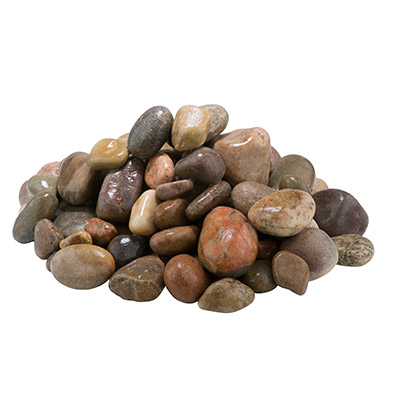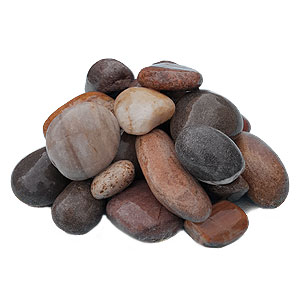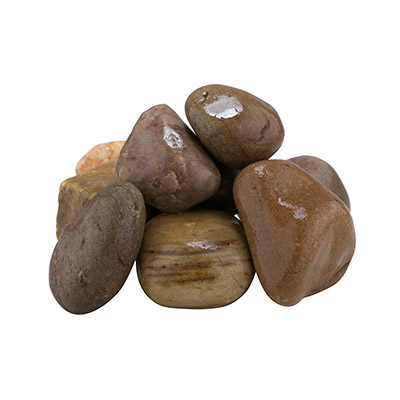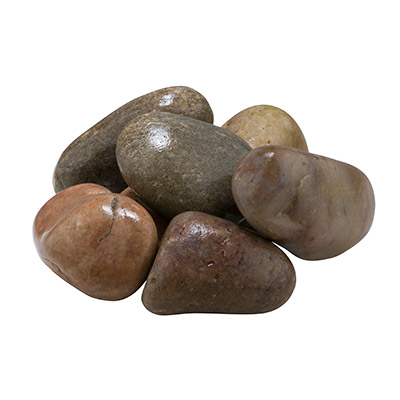Sourced from Highland quarries and remote parts of the Scottish coastline, Scottish cobbles provide an attractive and popular paving option that is suitable for use in a wide range of outdoor spaces, including gardens and driveways.
These naturally rounded stones have a beautiful, rich earthy hue with a slightly glossy finish, achieved through years of weathering. A hard-wearing and versatile material for areas that receive heavy use, such as driveways and courtyards, Scottish cobbles are a smart choice that will look equally at home outside a period home or a new build.
The irregular shape of Scottish cobbles means that they provide better drainage than many traditional paving options. They are also relatively inexpensive and can be easily laid, even by those with limited DIY experience. Available in various sizes, ranging from the larger Scottish cobbles to the smaller Scottish pebbles, these stones can be used in many different ways to create a neat and stylish driveway that will truly stand the test of time.
The below tips will help you to choose, plan and lay your Scottish pebble or Scottish cobble driveway.
Decide whether to DIY or enlist a tradesperson
If you choose to get your Scottish cobble driveway laid by a professional, all of the hard work will be done for you and you can relax in the knowledge that your new driveway will be completed quickly and to a high standard. Another benefit to hiring a contractor is that they will be able to take away any waste removed from the site where your driveway will be laid. This is particularly useful as hardcore can be difficult and expensive to dispose of yourself.
While laying a driveway by yourself isn't necessarily difficult, it is labour intensive and there will be some heavy lifting involved. The DIY option is, however, significantly cheaper and once your driveway is finished you can take pride in your handiwork and enjoy showing off your newfound skills.
Top tip: If you do decide to take the DIY route, consider asking friends and family members if they are able to help out with some of the more difficult parts of the job.
Choose your cobbles and decide how to use them
While small Scottish pebbles are perfect for using loose, large Scottish cobbles can look particularly great when bound in resin, although this is likely a job for a contractor. At Decorative Gardens, you’ll discover a wide selection of Scottish pebbles and Scottish cobbles in a variety of different sizes to suit your needs.
Prepare the ground first
Before you can make a start on your new driveway, any existing paving slabs or tarmac will have to be removed. This can be done by breaking the surface into smaller parts with a jackhammer and then shovelling the waste out. This may be the most physically demanding part of making your new driveway - if you have friends who have agreed to help, now's the time to ask them over.

Lay a weed blocker
Once the site of your new driveway has been cleared and you have levelled the soil, it’s time to lay a weed blocker. This is a sheet of porous fabric that allows for drainage while preventing any weeds from growing up through your finished drive. A heavy duty weed blocker is best for use under driveways and comes with a 20-year guarantee.
Choose the right sub-base
Once your weed blocker has been put down, you need to lay a sub-base. For a driveway, you should use an MOT Type 1 sub-base - this is made from crushed material, usually granite or limestone, and helps to create a finished surface that will be strong, stable and hard-wearing. After laying your sub-base this then needs to be compacted - you will need a wacker plate for this. These can easily be hired from local or national tool hire companies, or you could hire a contractor just to do this part of the process.
Once your sub-base has been compacted, a level layer of sand should be laid on top.
Install a gravel grid or pave system
A gravel grid such as the Kelkay Gravel Pave System will stop your Scottish cobbles from spreading, helping to keep your driveway looking neat and tidy. Using a pave system is particularly important if your driveway will be used frequently or driven on. Make sure that you pick a system that is compatible with the size of the pebbles or cobbles that you have chosen.
Lay your Scottish cobbles or pebbles
Make sure you buy enough - you'll need more than you might think! While shovelling your Scottish cobbles or pebbles on top of your gravel grid or pave system may be time-consuming, this is the exciting part because it’s now that you get to see your finished driveway taking shape.
Once the pebbles are down, you might want to consider adding a decorative border. You could do this with block paving, edging stones, or with boulders or rockery stones, for more of a natural looking edge.
Top Tip: If you use bricks to create a border for your driveway, ensure that these are raised slightly above the level of the rest of the drive. This will provide an extra line of defence to stop your Scottish cobbles or pebbles from escaping.












